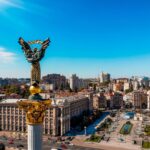For all its many examples of best practice, such as its world-leading system of digital public services and unique start-up culture, Estonia’s economy has been in the doldrums for some time.
Indeed, Estonia was the worst-performing economy in the EU in 2023 (the economy contracted by three per cent).
There are signs, however, of recovery. After a projected, slightly smaller contraction of one per cent in 2024, the Estonian economy is forecast to finally return to growth (1.1 per cent) in 2025 and by 2.6 per cent in 2026, as private consumption is set to recover—driven by restored purchasing power.
Nevertheless, the country’s outlook is riddled with caveats. The contraction in 2024 and projected weak growth beyond is a result of several factors, including the permanent loss of cheap inputs from Russia, rising wages that diminished Estonian competitiveness, weak growth in the country’s main trading partners, and lingering geopolitical concerns.
Increased government spending will provide limited support to growth as it shifts more towards military spending.
Despite these headwinds, Estonia retains core strengths that could help the economy rebound. A tradition of nimble governance and impressive digital know-how has placed the Baltic nation firmly on the technology map.
E-residency, for instance, has long been a magnet for entrepreneurs from across the globe, offering a transparent and convenient way to establish businesses within the European Union.
And while the Covid-19 crisis and subsequent geopolitical disruptions have dented investor confidence, Estonia’s world-class digital infrastructure remains an appealing draw.
Yet technology alone cannot shoulder the burden of economic recovery. The reality on the ground includes flagging consumer confidence, a volatile external environment, and structural issues such as persistent labour shortages and rising wage costs. The question now is whether Estonia can regain its former nimbleness and chart a path back to robust growth.
The start-up edge—and its limitations
Estonia’s famed start-up ecosystem is one of its brightest calling cards. Thanks to low administrative hurdles, a flourishing community of accelerators, and support from government agencies, the country has produced a disproportionate number of technology success stories.
Wise and Bolt, among others, have demonstrated that Estonian innovators can thrive on the global stage. These darlings of the digital economy have paved the way for a wave of smaller companies, keen to test new ideas in the friendly confines of Estonia’s regulatory sandbox.
Still, heavy reliance on the technology sector can be a mixed blessing. Not every start-up will achieve the same scale as the unicorns of yesteryear, and competition for software developers is fierce.
Rising wages—a mark of Estonia’s success—have, paradoxically, weighed on the competitiveness of the broader economy. For entrepreneurs, higher labour costs erode the advantage of setting up in Tallinn or Tartu rather than more established tech hubs in Western Europe or North America.
This could stifle the influx of smaller digital enterprises that have historically found Estonia an attractive springboard to the European market.
Manufacturing, energy, and beyond
Away from the much-publicised start-up scene, Estonia’s traditional manufacturing base has undergone seismic shifts.
For years, Estonian factories relied on a mix of cheap energy from Russia and cost-competitive labour. Both of these advantages have diminished. Many Estonian firms are now scrambling to secure energy sources elsewhere while also grappling with higher wage bills and, more recently, upward pressure on borrowing costs.
Nonetheless, there are pockets of resilience. Electronics and machinery, for example, have seen steady—if unspectacular—export growth, buoyed by demand from Nordic markets.
On the energy front, Estonia is pressing forward with renewable projects that tap into the country’s wind resources, both onshore and offshore. Under the banner of energy security, solar installations have multiplied, bolstered by EU green transition funds.
If harnessed effectively, these renewable initiatives could help Estonia not only reduce its dependence on imported fuels but also carve out a niche in high-value energy technology.
Opportunities for investment
For foreign investors, Estonia’s membership in the European Union and euro area remains a major draw, offering seamless access to the single market. Coupled with the government’s digital-first philosophy, this can significantly reduce administrative burdens.
Investors keen on technology, cybersecurity, and digital health will find a supportive environment in Estonia’s public agencies and research institutions.
Moreover, Estonia’s logistics and transport potential remains underutilised. The country’s strategic position between Scandinavia, Central Europe, and the broader Baltic region could support greater development of warehousing, distribution, and value-added services—particularly as supply chains continue to rebalance in the wake of geopolitical tensions.
With the right mix of public-private partnerships, Estonia could capitalize on shifts in manufacturing and shipping routes, adding new impetus to its battered economy.
Another avenue of promise lies in education technology (edtech) and digital public services, areas where Estonia has long been a pioneer. As more countries look to modernise their bureaucracies, Estonia’s well-established platforms and expertise in digitising governance could be marketed worldwide.
Some local companies are already exporting solutions that facilitate electronic voting, virtual municipal services, and streamlined tax filing—models that could be replicated in other parts of the world seeking to reduce corruption and increase government efficiency.
Consumer confidence: A sober mood
So far, signs of a revival in private consumption are tepid. With real incomes squeezed and inflation lingering—despite a recent slowdown—households remain cautious in their spending habits.
Big-ticket purchases have been deferred, and tourism receipts, while improving from pandemic lows, are yet to reach pre-2020 levels. Until wages rise in tandem with productivity, real purchasing power will remain under pressure.
Surveys suggest that Estonians are wary of taking on new debt, mindful that the era of ultra-low interest rates has ended. The housing market, once a key driver of consumer exuberance, is experiencing a slowdown in new construction starts. This has dampened sentiment in related sectors like construction materials, retail furnishings, and household appliances.
Government stimulus, which is tilting toward military expenditure rather than direct consumer support, may prove insufficient to jump-start domestic demand in the short term.
Risks and geopolitical underpinnings
Complicating the outlook is Estonia’s proximity to Russia and Belarus. The region’s heightened military posture has diverted public resources to defence and prompted foreign investors to tread carefully.
Though Estonia is well integrated into NATO and the EU, the risk of further disruption—be it cyber or conventional—casts a long shadow over the region’s prospects. A flare-up of hostilities could wreak havoc on Baltic trade routes or rattle consumer confidence.
Uncertainties in global energy markets also loom. Estonia’s rapid pivot away from Russian energy involves short-term pain, including higher input costs for businesses and households.
Efforts to build or expand LNG terminals in the region are part of the longer-term solution but require significant investment and coordination among Baltic and Nordic partners. Until these projects come online in full, Estonia remains exposed to fluctuating prices.
Policy and fiscal outlook
Estonia’s government, renowned for its small-state efficiency, is now balancing a desire for prudent fiscal policy with the need to protect vulnerable households and businesses. Nevertheless, both income tax and VAT will increase in 2025.
There is still room to harness EU structural funds more effectively, especially those earmarked for innovation, green transition, and competitiveness. Plans to digitise more state services, while laudable, must be supported by robust cybersecurity measures to protect both state and private data.
The central bank has signalled that interest rates may remain elevated for some time, mirroring policy trends across the euro area. Higher borrowing costs could slow investment, particularly among the small and medium-sized enterprises that form Estonia’s economic backbone.
Prudent management of public debt—historically one of the lowest in the EU—should grant Estonia some fiscal space, but how effectively this cushion is used remains to be seen.
A platform for renewal
Estonia’s digital chops have given it a global reputation that belies its small size, yet the country finds itself at a crossroads. Recent contractions underline structural challenges: a vulnerability to external price shocks, the loss of cheaper energy inputs, and wage-driven competitiveness issues.
Even so, the fundamentals of Estonia’s open, tech-savvy economy offer a platform for renewal.
In order for the recovery to gain momentum, both the public and private sectors must focus on more than just defence spending. Forward-looking policies—aimed at bolstering educational quality, attracting international talent, and expanding key infrastructure—could reignite growth.
Estonia’s capacity to reinvent itself in the digital sphere shows that adaptability is part of its national DNA.
If Estonia can tackle immediate headwinds while capitalizing on its innovative spirit, the country stands a good chance of shaking off its sluggish spell. The Balts have repeatedly demonstrated resilience in the face of stiff adversity.
With the right combination of policy discipline, international partnerships, and a renewed commitment to competitiveness, Estonia may once again become an exemplar of how a small nation can punch above its weight.
Photo by Single.Earth on Unsplash.







